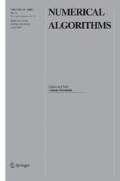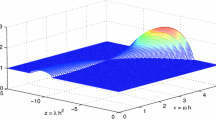Abstract
Explicit Runge–Kutta Nyström pairs provide an efficient way to find numerical solutions to second-order initial value problems when the derivative is cheap to evaluate. We present new optimal pairs of orders ten and twelve from existing families of pairs that are intended for accurate integrations in double precision arithmetic. We also present a summary of numerical comparisons between the new pairs on a set of eight problems which includes realistic models of the Solar System. Our searching for new order twelve pairs shows that there is often not quantitative agreement between the size of the principal error coefficients and the efficiency of the pairs for the tolerances we are interested in. Our numerical comparisons, as well as establishing the efficiency of the new pairs, show that the order ten pairs are more efficient than the order twelve pairs on some problems, even at limiting precision in double precision.
Similar content being viewed by others
References
Dormand, J.R., El-Mikkaway, M.E.A., Prince, P.J.: High-order embedded Runge–Kutta–Nyström formuale. IMA J. Numer. Anal. 7, 423–430 (1987)
El-Mikkawy, M.E.A.: Embedded Runge–Kutta–Nyström Methods. Phd thesis, CNAA (1986)
Enright, W.H., Pryce, J.D.: Two FORTRAN packages for assessing initial value methods. ACM Trans. Math. Softw. 13(1), 1–27 (1987). doi:10.1145/23002.27645
Filippi, S., Gräf, J.: New Runge-Kutta-Nyström formula-pairs of order 8(7), 9(8), 10(9) and 11(10) for differential equations of the form y′′ = f(x,y). J. Comput. Appl. Math. 14(3), 361–370 (1986). doi:10.1016/0377-0427(86)90073-7
Grazier, K.R., Newman, W.I., Kaula, W.M., Hyman, J.M.: Dynamical evolution of planetesimals in the outer solar system. I. The Jupiter/Saturn zone. Icarus 140, 341–352 (1999). doi:10.1006/icar.1999.6146
Hairer, E., Nørsett, S.P., Wanner, G.: Solving Ordinary Differential Equations. I: Nonstiff Problems. Springer Series in Computational Mathematics, vol. 8, 2nd edn. Springer-Verlag, Berlin (1993)
Holman, M.J.: A possible long-lived belt of objects between Uranus and Neptune. Nature 387, 785–788 (1997)
Horn, M.K.: Developments in High-order Runge–Kutta–Nyström Formulas. ProQuest LLC, Ann Arbor, MI. Thesis (PhD), The University of Texas at Austin (1977)
Ito, T., Tanikawa, K.: Long-term integrations and stability of planetary orbits in our Solar system. Mon. Not. R. Astron. Soc. 336, 483–500 (2002). doi:10.1046/j.1365-8711.2002.05765.x
Kahan, W.: Further remarks on reducing truncation error. Commun. ACM 8, 40 (1965)
Papakostas, S.N., Tsitouras, C.: High phase-lag-order Runge–Kutta and Nyström pairs. SIAM J. Sci. Comput. 21(2), 747–763 (electronic) (1999). doi:10.1137/S1064827597315509
Prince, P.J., Dormand, J.R.: High order embedded Runge–Kutta formulae. J. Comput. Appl. Math. 7(1), 67–75 (1981). doi:10.1016/0771-050X(81)90010-3
Sharp, P.W.: Numerical comparisons of some explicit Runge–Kutta pair of orders 3 through 8. ACM Trans. Math. Softw. 17(3), 387–409 (1991). doi:10.1145/114697.116811
Sharp, P.W.: N-body simulations: the performance of some integrators. ACM Trans. Math. Softw. 32, 375–395 (2006). doi:10.1145/1163641.1163642
Sinclair, A.T., Taylor, D.B.: Analysis of the orbits of Titan, Hyperion, and Iapetus by numerical integration and by analytical theories. Astron. Astrophys. 147, 241–246 (1985)
Author information
Authors and Affiliations
Corresponding author
Additional information
The work of the second author was supported by the Higher Education Commission of Pakistan.
The work of the third author has been conducted in part at the Jet Propulsion Laboratory, California Institute of Technology under a contract with the National Aeronautics and Space Administration. Government sponsorship acknowledged.
Rights and permissions
About this article
Cite this article
Sharp, P.W., Qureshi, M.A. & Grazier, K.R. High order explicit Runge–Kutta Nyström pairs. Numer Algor 62, 133–148 (2013). https://doi.org/10.1007/s11075-012-9571-0
Received:
Accepted:
Published:
Issue Date:
DOI: https://doi.org/10.1007/s11075-012-9571-0




